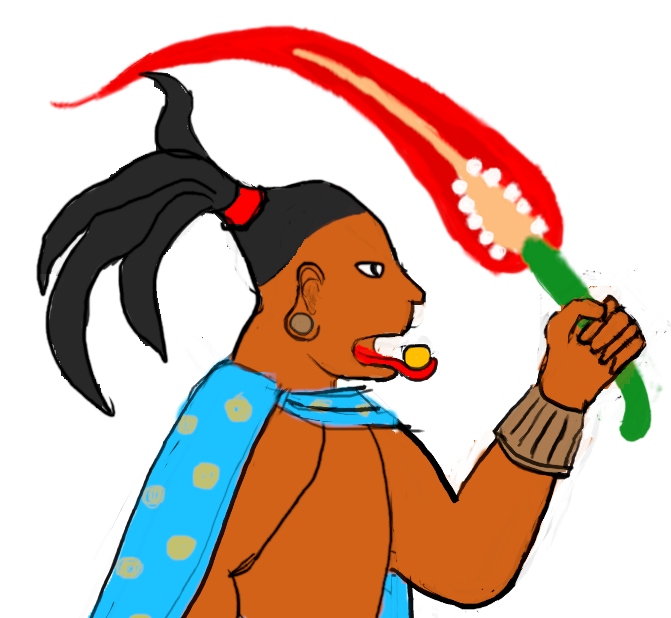Nem script
The Nem script is the most widely used writing system on Salan. The script is mainly used to write in Nem (Faren language).
After its invention by the Farens, the writing system spread rapidly over Salan through the trade relations between the neigbouring peoples. It is believed that the need for literacy in Nem helped to spread the language as well, and it is known that already by 200 AFS Nem was spoken over much of the current Farensal.
Some of the most resent sound changes of Nem are not represented in writing, for example the diphtongised long vowels in the first syllables are often written as the original long vowels (í pro ai). The consonant y [j] doesn't have it's own letter. It appears regularly in the words beginning with i or e (ente 'he / she' [yente]) or word-medially in [ai] or [ia] diphthongs (sai 'two' [say]).
The Zeribian abjad is clearly the descendant of the cursive style Nem, sharing its wavy shapes and connected letters. This is understandable, because it was developed from the merchants' handwriting, likely with little influence from the traditional Nem literature or monumental architecture.
ramku bex uten washmaq mahnginkal
ym mahze i dew i unguzedeg sasyr
ungugwel washkash sasyr
ga ukan nezen gwesh neg rimkash i ubugrish
One day a farmer went
to his field for picking chiles.
When he cut open one chile pod,
suddenly a great light came out of it, and he was blinded.
Literacy
The Nem speaking area has quite high literacy rates, especially in the towns. However, many commoners working in physical labour can not read at all. Approaching the borders of the Nem speaking area, the rates drop dramatically, because of the difference of the local dialects and standard Nem. Many peoples around the Farens still write exclusively in Nem, although some versions have been adaped for other languages (see: Variations).History
The oldest known piece of writing is found on a stele commemorating the 200th anniversary of the Founding of Silford (thus year 200 AFS), although the tradition places the invention much closer to the founding of the city. According to the Myth of the spirit swan writing was gifted to the Farens by the god Naruseiń, who send them a perfect swan. They managed to trap the swan, and harvest it's perfect quills and blood for writing the first words.After its invention by the Farens, the writing system spread rapidly over Salan through the trade relations between the neigbouring peoples. It is believed that the need for literacy in Nem helped to spread the language as well, and it is known that already by 200 AFS Nem was spoken over much of the current Farensal.
Properties
The Nem Script is an alphabet. The script is usually written left-to-right, and top to bottom, although right-to-left is also seen, especially in the oldest samples. Because the script was developed specifically for Nem, the system is fairly regular and well suited for writing in Nem. There are 22 main letters that represent the vowels and consonants. In addition, diacritics are used to mark the long vowels.Some of the most resent sound changes of Nem are not represented in writing, for example the diphtongised long vowels in the first syllables are often written as the original long vowels (í pro ai). The consonant y [j] doesn't have it's own letter. It appears regularly in the words beginning with i or e (ente 'he / she' [yente]) or word-medially in [ai] or [ia] diphthongs (sai 'two' [say]).
Writing medium
Nem script is usually written on paper with pen. The pens are usually made from goose quills, and thus the geese are considered holy animals of the God of Literature Naruseiń. The script itself is varied based on the writing medium. The so-called monumental style is used when carving on stone or metal, or for display purposes. It is characterised by sharp angular shapes. The cursive style, on the other hand, is used when writing everyday texts on paper. It has curvy connected letters, enabling faster handwriting.Example text
This is the opening passage from the epic Songs of Kauteirin, describing the birth of the Heroes Daursan and Kauteirin. The style used here is the monumental version, for example purposes. Actual manuscripts of the epic are written in the cursive style. Keińi peked Ásinnar Táldar ná ahal hanra
Walginnit ked gadmacinei welesek nenu çelled
Ná felesek pendled ás mai paun ná penbeinsed
Táldarek ente ra’ nemled ássit sára Sasinfa
Ai maiyek den nemled sárá yenteli’ Táldár
Ai arnállit maikein kes nemled Ásinnar
Walginnit ked gadmacinei welesek nenu çelled
Ná felesek pendled ás mai paun ná penbeinsed
Táldarek ente ra’ nemled ássit sára Sasinfa
Ai maiyek den nemled sárá yenteli’ Táldár
Ai arnállit maikein kes nemled Ásinnar
Hero Ásinnár was pregnant and when the time of
birth came near, she went to a small village for shelter
An old widow took her to her house
She said her name was Sasinfa Greyhair
but the Hero did not tell her her name
But said: ”I'm just a peasant girl”
birth came near, she went to a small village for shelter
An old widow took her to her house
She said her name was Sasinfa Greyhair
but the Hero did not tell her her name
But said: ”I'm just a peasant girl”
Variations
Zeribian abjad
Zeribian has repurposed the Nemscript for its consonant heavy language, by generally not writing the vowels, making this version a consonant script or an abjad. Evidence suggests, that first W was used to mark the common semivowel w. After that there was little use for marking all the other vowels, and a general vowel mark was used for them. Currently vowel marks are only used if necessary to point out the difference, and a small vowel letter can be written above the consonant or a vowel mark to specify the vowel. This development freed Nem Script vowel signs to be used for consonants not found in Nem.The Zeribian abjad is clearly the descendant of the cursive style Nem, sharing its wavy shapes and connected letters. This is understandable, because it was developed from the merchants' handwriting, likely with little influence from the traditional Nem literature or monumental architecture.
Example text
Birth of the god Usahdeg.ramku bex uten washmaq mahnginkal
ym mahze i dew i unguzedeg sasyr
ungugwel washkash sasyr
ga ukan nezen gwesh neg rimkash i ubugrish
to his field for picking chiles.
When he cut open one chile pod,
suddenly a great light came out of it, and he was blinded.
Tasalian
Tasal language unlike Nem, is a tonal language. However, the tones are usually not marked in writing. This is prone to leading into some ambiguity, for example, /ka/ can mean either ká 'and', ká 'I', kà 'we', or ka 'to kill'. Repurposing the Nem long vowel marks for marking tone has been suggested by some scholars, but the convention has not stuck with the common people.
Script type
Alphabet
Direction
Left-to-right, top-to-bottom
Writing medium
Pen on paper / carved on stone
Region
Farensal
Languages
Nem (Faren language)
Tasalian
Aradal
Alphabet
Direction
Left-to-right, top-to-bottom
Writing medium
Pen on paper / carved on stone
Region
Farensal
Languages
Nem (Faren language)
Tasalian
Aradal












Wow. Very nice job. Monumental form vs cursive and other variants.... really great.
Thanks! I wish I had more time to add even more examples, but I spent far too much time fighting with creating a cursive computer font, which I didn't even use yet :D